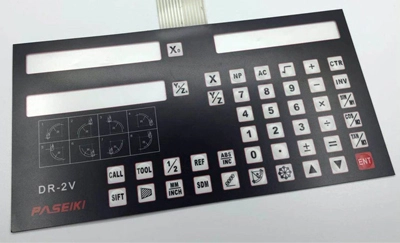
Flexible membrane switches are a typical form of membrane switches. The reason why this type of membrane switch is called flexible is that the mask layer, isolation layer, and circuit layer of the membrane switch are all composed of software films of various properties. The circuit layer of the waterproof flexible membrane switches is made of polyester film (PET) with good electrical performance as the carrier of the switch circuit pattern. This layer is also equipped with shrapnel and upper and lower circuits. Due to the influence of the properties of the polyester film, the membrane switch has good insulation, heat resistance, folding resistance, and high resilience.
The graphics of the switch circuit, including the connection of the switch and its outgoing wires, are printed with low-resistance, low-temperature-cured conductive paint. Therefore, the entire membrane switch has a certain flexibility, and it is not only suitable for use on a flat body, but also can be matched with a curved body. The lead wire of the flexible membrane switch is integrated with the switch body itself. When making the connection of the group switch, gather it in a certain place of the film, and extend outward according to the position specified by the design and the standard line distance, as a soft, bendable, sealed lead wire and connect connected to the rear circuit.
A rigid membrane switch means that the graphics and circuits of the switch are made on a commonly printed circuit copper-clad laminate. The rigid membrane switch is characterized by convenient material selection, stable process, and low resistance, and some components in the circuit can be directly welded on its back. In the case of a small area, the hard backing layer can be omitted. Rigid membrane switches generally use metal guides as conducting labyrinth contacts, which have a good feel. The disadvantage is that it is not as convenient as a flexible membrane switch when assembling and connecting the whole machine, and it is often necessary to solder the plug-in and lead out the lead through a flat cable. Except for the buzzer signal and LED indication, the information feedback of the rigid membrane switch can generally use metal shrapnel.
Usually, the keys on the membrane switch just use color to express the position, shape, and size of the key body. In this way, the accuracy of the operation can only be recognized by the operator's vision, and because there is no appropriate feedback information to indicate whether the finger is in the effective range of the switch to make the switch move, it affects the confidence in the monitoring of the whole machine and the speed of operation. A type of membrane switch that makes the switch key slightly protrude and is slightly higher than the panel to form a three-dimensional shape, which is called a three-dimensional key switch. The three-dimensional key can not only accurately specify the range of the key body, improve the recognition speed, and make the operator's touch more sensitive, but also enhance the decorative effect of the product's appearance. The production of three-dimensional keys must be arranged in the design stage of the panel, and process holes must be prepared for accurate positioning during mold pressing. Generally, the height of the three-dimensional protrusions should not exceed twice the thickness of the substrate.
In order to beautify the appearance of the product, the protrusions of the raised membrane keypads produced by the membrane keypad manufacturer can be made in a variety of ways. It must be arranged in the design stage of the panel, and process holes are provided so as to have accurate positioning when the mold is pressed, and the three-dimensional height of the protrusions should generally not exceed twice the thickness of the substrate.